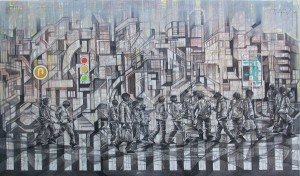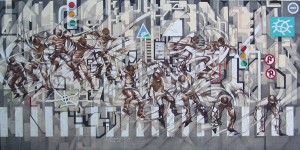Sugihartono vividly describes how the time machine painstakingly reaches its objective in every single person of urban people. The building, road, skateboard, stilt, and everything else are just representations that can be read as sign, while it is clear that behind it, it is the time machine that enables people to be there – moving without its individual subject.
It is revealed to us clearly each day that life at its face value can be seen on the street, at work, in malls, cafés, which present people merely as moving figures. Sugihartono unmasks the exteriority and the interiority of the time machine; the urban life and the time machine itself, where people are going to and fro without regards to each others, which in itself is a repetitive problem that gives raise to the classic question: what is the meaning of life?
Time machine concludes the meaning where human is now free of its being (ontologically). Therefore the issue of human dualism of body and soul melts into the time narration that demands such work maximization! Without doubt, all Sugihartono work offer us with implication that we are now inside the mechanistic repetition of time; carried away in the time movement that spies on the direction we are heading every time we take a step. Nothing is left?
Time is the only witness that could testify that we or our live was there and it amuses us to search for the source of that life. Generally, we already understand this concept of time that we call ‘nostalgia’. It is most probable that to Sugihartono we are still in possession of such memories of the past and it raises the question of whether time machine can totally obliterate the individual person significance.
In this regards Sugihartono tickles us on the ‘modification’ modus that signify whether nostalgia is a hidden energy that would reveal itself and present us with human creativity in overtaking the mechanistic time machine? That work is purely for the sake of work without giving any new meaning to it? That human work for a reason but then abandons the reson itself because of time constraint in their work. Ironic!
Catalog:
Time Machine
Urban in Between
Sugihartono
Gresik, October 21, 1967
IKIP Fine Art Surabaya 1988
Selected Group Exhibitions:
2013
“Time Machine”, Philo Art Space, Jakarta, Indonesia
“Meta-Amok”, Seni Rupa Nusantara, Indonesia Nasional
Gallery, Jakarta Indonesia
“Festifal Tangerang”, Universitas Multimedia Nusantara
2012
“Idiotisme”, Rumah Seni Gudeg Citra Raya, Tangerang
“Show Time”, Jonant Galeri Tangerang
2011
“Haul Pak Harto”, Crown Plaza-Jakarta
2010
JAM “The Second God” Indonesian National Gallery, Jakarta
Indonesia
“Urban in Between”, Philo Art Space, Jakarta , Indonesia
“Breakin the Wall”, Grand Theater TIM,Jakarta
2009
“Urban Behaviour”, Philo Art Space, Jakarta, Indonesia
“Menjadi Indonesia”, Studio Kayan, Gedung Arsip Nasional
Jakarta, Indonesia
2008
“Jakarta Awakening Arts”, Hotel Sultan Jakarta, Indonesia
“Fantasy Object”, Millenium Gallery, Jakarta Indonesia
“Setelah 20 Mei”, Jogja Gallery, yogyakarta,Indonesia
“JAA”, Galeri Pasar Seni Ancol, Jakarta Indonesia
“The Silence of City”, Denindo Art House, Jakarta
“Indonesia Today”, Linda Gallery Siangapre
2007
“Demi Ma(sa)”, Seni Rupa Nusantara, Indonesian National
Gallery, Jakarta Indonesia
“Keseimbangan, Serabut”, Rumah Seni Gudeg Citra
Raya, Tangerang, Indonesia
“Matra Realisme”, Gallery Surabaya, Surabaya East Java
2006
“Dari Cela Pabrik”, Rumah Seni Gudeg Citra Raya,
Tangerang, Indonesia
2005
“Dari Negri Pabrik”, Taman Ismail Marzuki, Jakarta, Indonesia
“For Aceh”, Indonesian National Gallery. Jakarta, Indonesia
“3+3=?”, Rumah Budaya Titi Hijau, Gading Serpong,Tangerang
2004
“Exhibition In Memory”, DIS, Serpong Tangerang
1998
“Bebas Bicara”, Dewan Kasenian Surabaya, Surabaya East
Java
“Warna-Warna”, Westin Hotel, Surabaya, East Java













